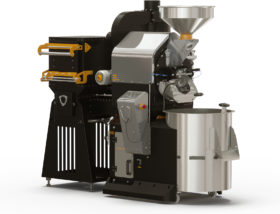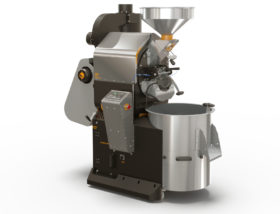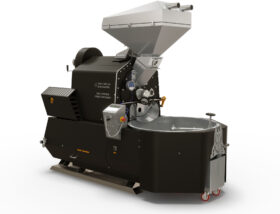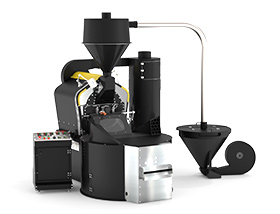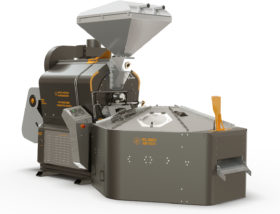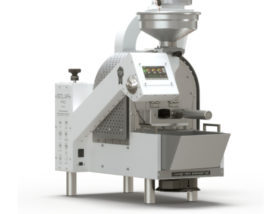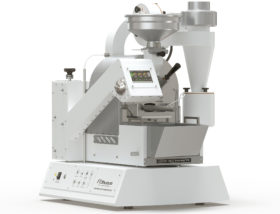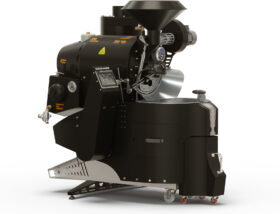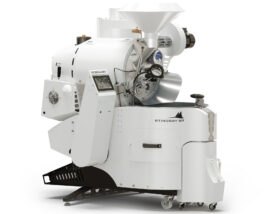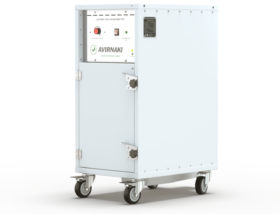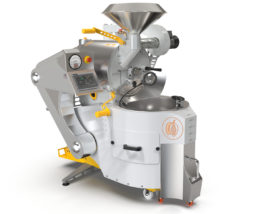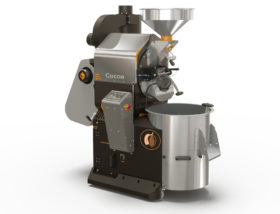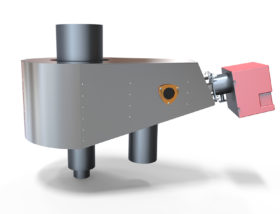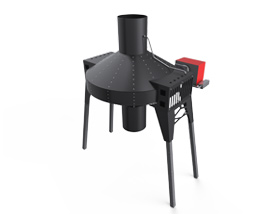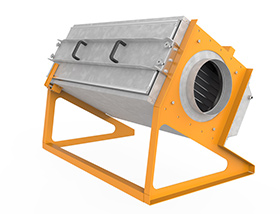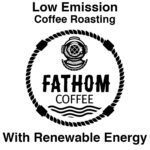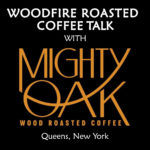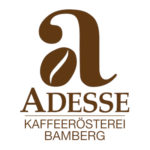
In todays modern coffee industry gas roasters are used by the vast majority of roasteries and has been the case for nearly 70 years. Though most living people have always enjoyed coffee roasted in this manner, using gas as a fuel source is a relatively new development in the history of coffee. In the 1950’s roasteries were transitioning away from wood roasters and other alternative fuel sources to take advantage of the newly available condensed gaseous fuel. With the introduction of large scale factories, the assembly line, and roadway infrastructure, so too came the industrialization of the coffee business. Coffee would no longer be roasted by the town roastery, instead coffee would enter the phase where it was roasted in much larger facilities with larger equipment in larger batch sizes, then distributed at great distances to be made available on store shelves occupying the territories in between. The key incentives for this transition were driven by convenience and accessibility, not necessarily due to the quality or flavor of the finished product. Smaller, local, artisan roasteries could not compete against the larger facilities with more modern production and newly obtainable, wide ranging market capabilities.
A couple generations later, we have seen the worldwide reemergence of smaller batch artisan roasteries who now emphasize quality over all else. With the endless options modern coffee drinkers have, combined with small roasteries now having easy access to the expanding market, the demand for top quality and niche flavored coffee is larger than ever. Along with this revival of artisan quality in everyday coffee consumption, there has been demand for roasting machines that use more traditional fuel sources to provide a more traditional taste. With this change in pallet, we are seeing wood roasters become a desired tool for artisan roasteries who want to bring flavor profiles that reflect the old heating methods. When done right, the extra flavors and aromas added by the wood energy source creates a cup profile that is distinct and well remembered. For roasters who have the patience and time to perfect their craft, wood roasted coffee brings something to the table that is left out with conventional gas roasters.
Mighty Oak Roasters in the Astoria neighborhood of Queens, New York is a compact coffee shop and roastery that pays extra attention to the fine details of their coffee. Sean Donnelly and Peter Moses started Mighty Oak Roasters in May, 2019 and have experienced continuous growth and local support since opening. Resting on a street corner within a residential area, Mighty Oak Roasters 1000 Square foot establishment seems to be the perfect addition to beautiful neighborhood on the outskirts of Queens. Utilizing a Ghibli R15 Firewood Coffee Roaster, Mighty Oak offers a cup of coffee that stands out among the crowd. Due to the rich body and balanced acidity of their artisan coffees, available with accents of oak, cherry, ash and other assorted hard woods, their customers can experience a cup of coffee that is truly unique and different than what they have had in the past. I recently had an opportunity to speak with Sean Donnelly of Mighty Oak Roasters about how they got started, what has been their experience roasting coffee with a woodfire, and what lessons they learned that could assist others in their pursuit of coffee development and roasting options.
Q: How did you get into the coffee business?
A: I started as a home roaster, originally using a cast iron pan on a grill in the back yard. Over the years I’d give beans to friends and family, and eventually some local restaurants asked to start buying from me, so it became clear I had to scale up.
Q: How would you describe your business in ONE sentence?
A: Mighty Oak roasts carefully sourced coffees from around the globe using sustainably harvested local hardwoods using the only Woodfired Coffee Roaster in the region.
Q: What is the thing that you are most proud of in your business?
A: I’m very proud of how much we’ve become a part of the community. I started roasting at home since we didn’t have a specialty roaster or café in our neighborhood, so my goal was to build the shop that I had always wanted nearby.
Q: Tell us a little about the location of your business – the city, scene etc.
A: We’re in the Astoria neighborhood in NYC’s borough of Queens. Astoria is home to multi-generational families as well as new residents of the city, since it’s close to Manhattan for commuters, but is a quieter neighborhood with a strong community feel.
Q: What influenced the name of your coffee shop?
A: I was looking for a name that would reference our Woodfired roasting process, but not rely on it. The inspiration came from an oak tree near where I grew up dating to the 1600’s, but more specifically fans of the 90’s tv show Mystery Science Theater 3000 may get the reference.
Q: Why did you choose roasting with wood instead of the more common gas burner?
A: I discovered wood roasting sort of accidentally. When I first started, I roasted over a wood/charcoal fire outdoors. After I started using a proper electric element roaster I found there was something lacking, and my research led me to the CTE Ghibli which was the only roaster I could find that offered a high degree of control while using a live fire heat source.
Q: What are the outstanding pros and cons of roasting with wood (if there are any of either)?
A: Wood roasting inherently has a different flavor profile. Partly from the humidity in the heat I believe, we find that we can actually use longer roast times without baking. This tends to result in more sweetness and a very balanced profile, combined with just a bit of the wood aromatics. The challenge is you have to control it, which takes quite a bit of practice, and changes can’t really be made as quickly as with a gas burner. If you start with too little fuel you can end up stalling or spiking mid-roast, and conversely too big of a fire cannot simply be turned down. There is also the challenge of sourcing fuel, not something you have to worry about past installation with a gas burner. Thankfully, in the northeast US we have a great deal of suitable hardwoods available, primarily from storm damage and managed forests. Even still, there’s a lot of work that goes into splitting and conditioning to ensure it burns properly.
Q: Would you recommend others to explore wood roasting? Is it something easy to start with or would you recommend exploring this option after a little experience?
A: Wood roasting probably isn’t for everyone, if you’re just starting out it may be a bit overwhelming to learn the fundamentals of roasting while also trying to control a fire. That said, we have trained a few roasters who have only roasted on our woodfired Ghibli, and they have done quite well.
Q: What is the latest thing you have discovered/your latest obsession in the coffee world? (roasting method/coffee variety/preparation method…etc)
A: It might not sound as exciting as the latest experimental anaerobics from the Don Eli Micromill (though we’re roasting one of those right now as well) but I’ve had a couple of AMAZING decaf coffees lately. In particular we have a washed coffee from Flor Del Café in Huehuetenango on espresso right now that’s incredibly sweet, clean, and complex. It’s a market that is usually underserved, and we’ve received a lot of great feedback as a result of providing a quality decaf option.
Q: Is there a blend or single origin that you believe your shop excels with?
A: I’m very proud of all the coffees we source, but there’s no question the Cold Brew blend was an innovation. What many people praise about cold brew – its lack of acidity – is I think, why I never really enjoyed it. I found that using a dry (natural) process coffee, I could gain back some fruit and berry notes that would come through in a cold extraction. Pairing that with a high-ish altitude washed central makes for a uniquely complex profile in what is otherwise a pretty one dimensional brewing method.
Q: Can you give an example of one mistake that you made and would have changed had you had the chance to start over again?
A: When we found our location, we were perhaps a bit too eager to get the location we wanted, and underestimated the work we’d have to do to open. The previous tenant was an abandoned pizzeria, and we agreed to take the space as-is. This meant a lot more work than we thought it would be, and delayed our opening by almost a year.
Q: Do you believe there are any upcoming challenges that will burden the coffee industry? What are they?
A: I think environmental sustainability will be an issue sooner than we think. An Arabica tree takes years to begin producing cherries, and in some regions conditions are changing faster than that. Changing conditions also allow pests and disease to thrive at higher altitudes, like we saw with the Roja outbreak in Central America in recent years. Equally important, if we as roasters and consumers don’t adjust our prices to factor in the cost of production to support a sustainable model for growers, specialty coffee will cease to exist. Coffee is largely a generational crop and if the next generation does not see a sustainable living, they’ll simply stop growing it.
Q: Can you recommend a good farm or co-op to purchase raw coffee from?
A: Year after year one of my favorites is the Suke Quto washing station in Guji. Tesfaye Bekele has done tremendous work to support his community and the land around them, while growing truly excellent coffee that is a pleasure to roast.

Mighty Oak Roasters is committed to ethical environmental practices in every aspect of their business. They receive their firewood from an arborist who collects naturally downed trees within 50 miles of their location and they have also installed a Commercial Avirnaki smoke elimination system to ensure that the byproducts of their roasts are safely trapped and disposed of in a way that is not harmful to the environment. Sean and Peter also place effort into sourcing their coffees from farmers that are harvesting with socially and economically sustainable practices, creating partnerships with the farmers to ensure they are getting the best produce at fair prices. In turn, this provides the farmers with increased incentive and capital to maintain and improve the growing conditions of their fields, resulting in sustained or better future harvests. Mighty Oak Roasters has successfully introduced delicious, traditional, wood roasted coffee to their modern coffee market.
Thank you Sean Donnelly
Chris Nance / Moshav Mazliach / February 23, 2023
